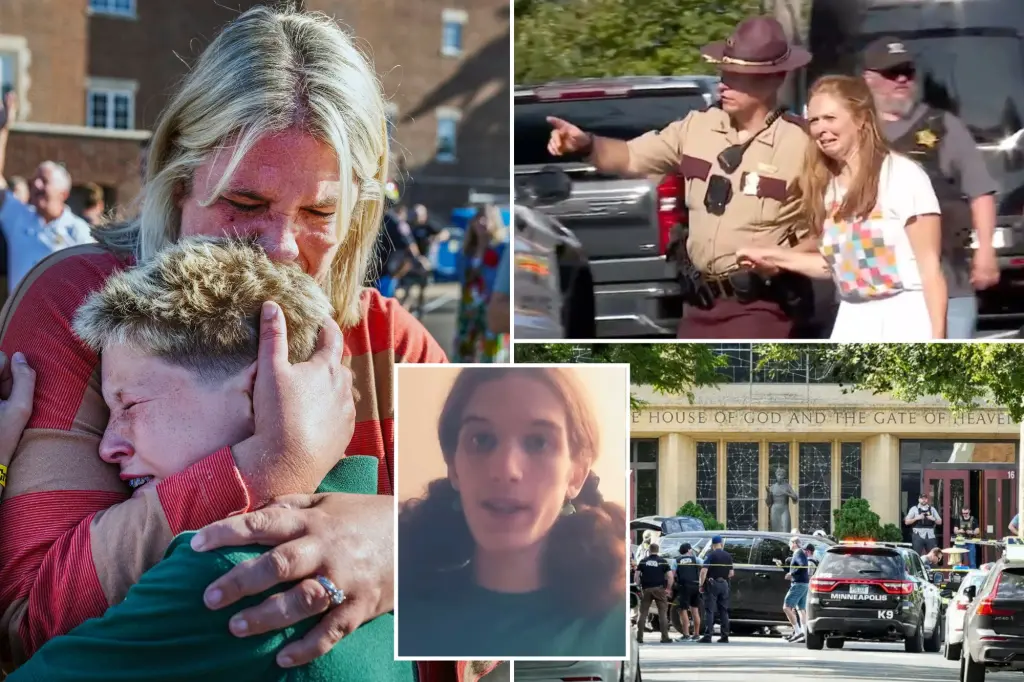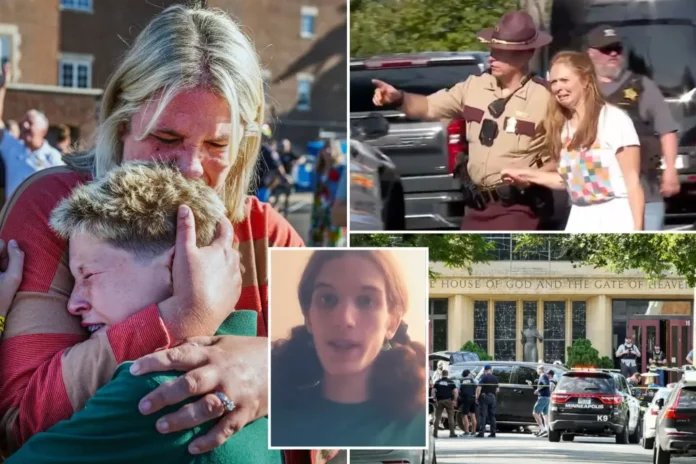😱 A CHILLING REVELATION ROCKS MINNEAPOLIS! 😱 Robin Westman’s manifesto has surfaced, exposing a twisted mind obsessed with chaos and past dictators. What drove this tragedy at a school church? Dark secrets hint at a childhood fascination with evil, but the full truth is shrouded in mystery. 😞 Dare to uncover the haunting details behind this heartbreaking event? Click to learn more. 👉

On August 27, 2025, a horrific act of violence shook Minneapolis, Minnesota, when a shooter opened fire at Annunciation Catholic School and Church during a morning Mass, killing two children, aged 8 and 10, and wounding 17 others, including 14 children. The perpetrator, identified as 23-year-old Robin Westman, died by suicide at the scene, leaving behind a chilling manifesto that has sparked intense scrutiny and debate. This document, shared through YouTube videos and handwritten journals, offers a disturbing glimpse into a troubled mind obsessed with mass violence and notoriety. While early reports noted Westman’s childhood admiration for Adolf Hitler, the manifesto itself paints a more complex and nihilistic picture, raising questions about motive, mental health, and the broader societal implications of such tragedies.
The Attack and Its Aftermath
The shooting occurred shortly before 8:30 a.m., as students and parishioners gathered for a Mass marking the start of the school year. Westman, armed with a legally purchased rifle, shotgun, and pistol, fired 116 rounds through the church’s stained-glass windows, targeting children in the pews. Wooden planks were placed to barricade side doors, trapping victims inside. Minneapolis Police Chief Brian O’Hara called the act “absolutely incomprehensible,” emphasizing the cruelty of targeting innocent children. The two young victims, along with 14 other children and three elderly parishioners among the wounded, underscored the indiscriminate nature of the violence.
Westman, who had no significant criminal record, died from a self-inflicted gunshot wound in the church parking lot. Authorities searched three related locations, recovering additional weapons, and confirmed Westman acted alone. The FBI, under Director Kash Patel, is investigating the incident as an act of domestic terrorism and a hate crime targeting Catholics, citing anti-religious and hateful references in Westman’s materials. However, extremism analysts argue the attack aligns more with a trend of nihilistic violence driven by a fascination with mass shooters rather than a coherent ideological agenda.
The Manifesto: A Window into Chaos
Westman’s manifesto, primarily disseminated through two YouTube videos (now removed), included a handwritten journal written phonetically in English but using Cyrillic script, totaling over 200 pages. Another video showcased a letter to family and friends, alongside weapons adorned with hateful phrases like “Where is your God?” and “Kill Donald Trump.” The journal revealed a deep obsession with mass shootings, particularly school shootings, dating back to Westman’s exposure to the 2012 Sandy Hook massacre in seventh grade. “Every school I went to, I have some fantasy at some point or another of shooting up my school,” Westman wrote, also mentioning similar fantasies about workplaces.
Contrary to initial reports, the manifesto explicitly denied racism or white supremacy as motives, with Westman stating, “I don’t want to do it to spread a message. I do it to please myself. I do it because I am sick.” The writings expressed a desire for infamy, describing the planned attack as a “masterpiece” and “art,” with references to notorious killers like Adam Lanza (Sandy Hook), Dylann Roof (Charleston), and the 2018 Kerch Polytechnic shooter. Weapons bore symbols and phrases tied to past massacres, such as “НЕНАВИСТЬ” (Russian for “hatred”) and a nod to the 2022 Highland Park parade shooting, suggesting Westman’s immersion in online subcultures venerating violence.
The manifesto included hateful rhetoric targeting multiple groups—Christians, Jews, Black people, LGBTQ+, Muslims, and Hispanics—with phrases like “6 million wasn’t enough” and “Burn Israel” written on weapons. A smoke bomb labeled “Extra Thicc! Jew Gas” further highlighted the shooter’s antisemitic and inflammatory rhetoric. Yet, analysts like Amy Cooter from the Institute for Countering Digital Extremism argue these were less ideological convictions and more attempts at shock value, part of a “stew of hatreds” designed to garner attention within nihilistic online communities.
The Hitler Connection
Early reports cited a former classmate, Josefina Sanchez, who told KSTP that Westman, during grade school in St. Paul, would “put up his hand and praise Hitler,” indicating disturbing behavior from a young age. This claim fueled speculation about ideological motives, but the manifesto itself does not explicitly reference Hitler as a “friend” or central figure. Instead, it focuses on a broader fascination with mass killers, suggesting the childhood behavior was an early sign of Westman’s troubled mindset rather than a coherent ideological stance. The discrepancy highlights the danger of conflating isolated statements with the shooter’s broader intentions, as the manifesto prioritizes violence for its own sake over any specific belief system.
Mental Health and Warning Signs
Westman’s writings revealed significant mental health struggles, with statements like “I am not well. I am not right” and “I have been severely depressed and suicidal for years.” A particularly haunting entry read, “FIND ME I AM BEGGING FOR HELP, I AM SCREAMING FOR HELP,” suggesting a desperate plea that went unanswered. Despite these admissions, authorities found no record of state-ordered mental health treatment. Westman’s journal also noted a “loving family” and “good support system,” yet expressed a disconnect: “For some reason, the fact that I have a pretty good life and the fact that I want to kill people have never correlated to me.”
:max_bytes(150000):strip_icc():focal(492x390:494x392):format(webp)/robin-westman-youtube-12290-Nurse-Mom-Minneapolis-victim-7d43b6f8e98246338fb4c4e3a8b7432e.jpg)
Westman’s connection to Annunciation Catholic School added complexity. Their mother worked there until 2021, and Westman attended the school for at least one year, graduating in 2017. Recent visits under the pretense of reconnecting with the Catholic faith were likely scouting missions, as Westman’s journal detailed plans to lock victims inside and noted teacher locations. Former classmates described Westman as “different” but not overtly violent, with one recalling occasional anger but no major incidents. The shock of Westman’s actions was palpable, with neighbor Terry Cole describing the family as “wonderful” and the community as tight-knit.
Societal and Cultural Implications
The Minneapolis shooting reflects a troubling trend identified by extremism analysts: young individuals radicalized in online subcultures that glorify mass violence. Westman’s materials echoed the aesthetics of the “True Crime Community” (TCC), which venerates killers like the Columbine shooters or Sandy Hook’s Adam Lanza. References to pop culture, such as the “skibidi” meme, and phrases like “there is no message” suggest a performative element, designed to shock and gain notoriety. Cody Zoschak from the Institute for Strategic Dialogue noted that Westman’s curated online presence may not reflect true mental illness but an idealized “aesthetic” of unwellness popular in these spaces.
The shooting also sparked debates about gun control, mental health resources, and school safety. Minneapolis Mayor Jacob Frey faced both praise and criticism for rejecting “thoughts and prayers,” stating, “These kids were literally praying.” The Trump administration’s recent cut of $18.5 million from a Homeland Security program aimed at preventing mass shootings added fuel to the controversy, with critics arguing it weakened efforts to detect warning signs like Westman’s.
Community Response and Moving Forward
The tragedy left Minneapolis reeling, with memorials outside Annunciation Church honoring the victims. Survivors, including a 13-year-old who underwent surgery, and families expressed profound grief. Westman’s uncle, former Kentucky lawmaker Bob Heleringer, called it an “unspeakable tragedy,” praying for his sister and the victims’ families. The FBI’s investigation continues, focusing on Westman’s online activity and potential radicalization pathways, while analysts urge caution in interpreting the manifesto as a definitive explanation of motive.
Conclusion
The Minneapolis shooting is a stark reminder of the complex interplay between mental health, online subcultures, and access to weapons. Robin Westman’s manifesto, while revealing a fascination with violence and a childhood admiration for Hitler, lacks a clear ideological thread, pointing instead to a nihilistic desire for infamy. The tragedy underscores the need for better mental health support, online monitoring, and preventive measures to protect vulnerable communities. As Minneapolis mourns, the nation grapples with how to address the root causes of such violence. For updates on the investigation and ways to support the victims, follow local news outlets and community initiatives.
“In regards to my motivation behind the attack I can’t really put my finger on a specific purpose. It definitely wouldn’t be for racism or white supremacy,” the notebook said, according to CNN. “I don’t want to do it to spread a message. I do it to please myself. I do it because I am sick.”
Local outlet KSTP interviewed a woman who said she was a former classmate and brief friend of Westman in grade school in St. Paul.
“I knew that something was off, but I was a kid; how was I to know what to do?” Josefina Sanchez told the outlet. “…[Westman] would put up his hand and praise Hitler.”
KARE 11 reported that Westman’s mother worked at Annunciation until her retirement in 2021.
O’Hara said Westman opened fire from outside the church, striking both students and worshippers. The people who were wounded are expected to survive, the chief said.
